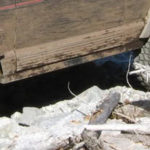Sooner or later you are going to drag the underside of your rig on a rock, and when that happens you are going to either be happy you have skid plates or really wish you did. I learned this the hard way with one of my first rigs when a triangular rock on the top of a berm caught on my transfer case and then rotated, cracking the housing of my transfer case.
The first areas of concern are your steering, radiator, oil pan, transmission, transfer case, gas tank, and emissions components. Not all of these will be vulnerable in every vehicle, and if you bought an "Off-Road" edition rig you may be lucky enough to have basic skid plates already.
The stock transfer case skid on a Jeep TJ. This is actually one of the better stock skid plates on 4wd vehicles these days, and it is adequate for moderately maintained roads, but if you high-center your rig on it then it will bend. A bent skid plate can bind up your shifters and create vibrations in your drivetrain.
If your gas tank is vulnerable then a good skid plate for it should be one of your top priorities. Nothing will end your day faster than puncturing your tank and losing all your gas, and denting the bottom of the tank will often damage your expensive fuel pump. Most vehicles come with a gas tank skid plate, but it is really no more than a guard against rocks being thrown up and will not protect your tank from dragging it on a rock.
Once you have the underside of your rig protected the next thing you should look at is the rocker area. Depending on your vehicle you may have options for frame mounted "Rock Rails" or body armor. Each style has advantages and disadvantages, and styles and feature vary greatly between manufacturers. Frame mounted rails can be stronger and can provide a better step, but give up ground clearance. Body armor needs to be very well designed to not pass stress upwards into the body where it can cause flexing and even cracking, but it gives more clearance. With either style I recommend choosing a design that sticks out from the side of your rig farther than the widest point on your doors so can slide along a tree or rock without denting your rig. What you don't want are "Nerf Bars" that are really just stylish steps and will fold if banged on a rock.






